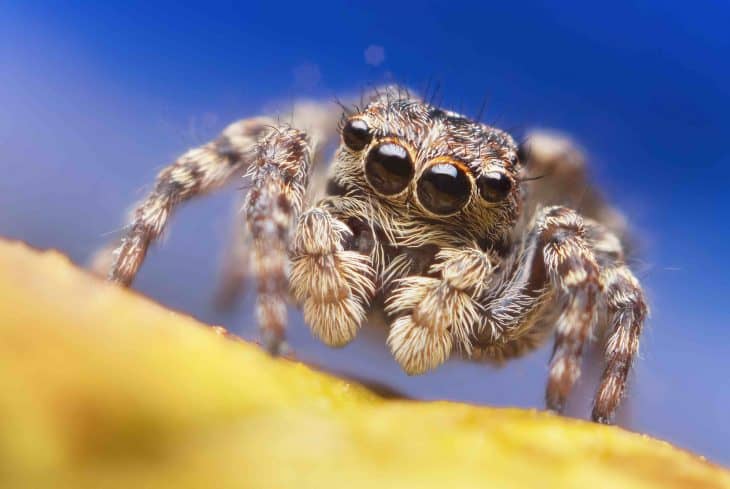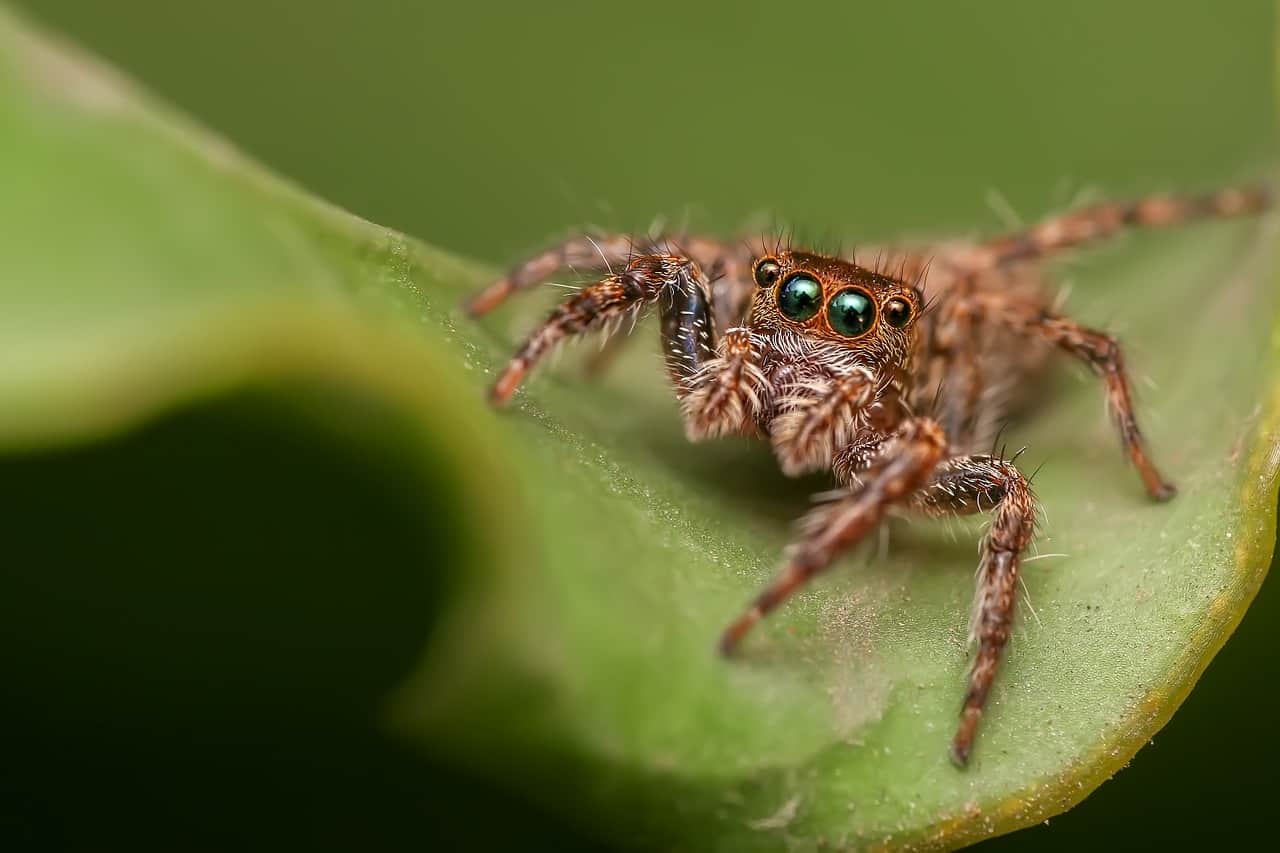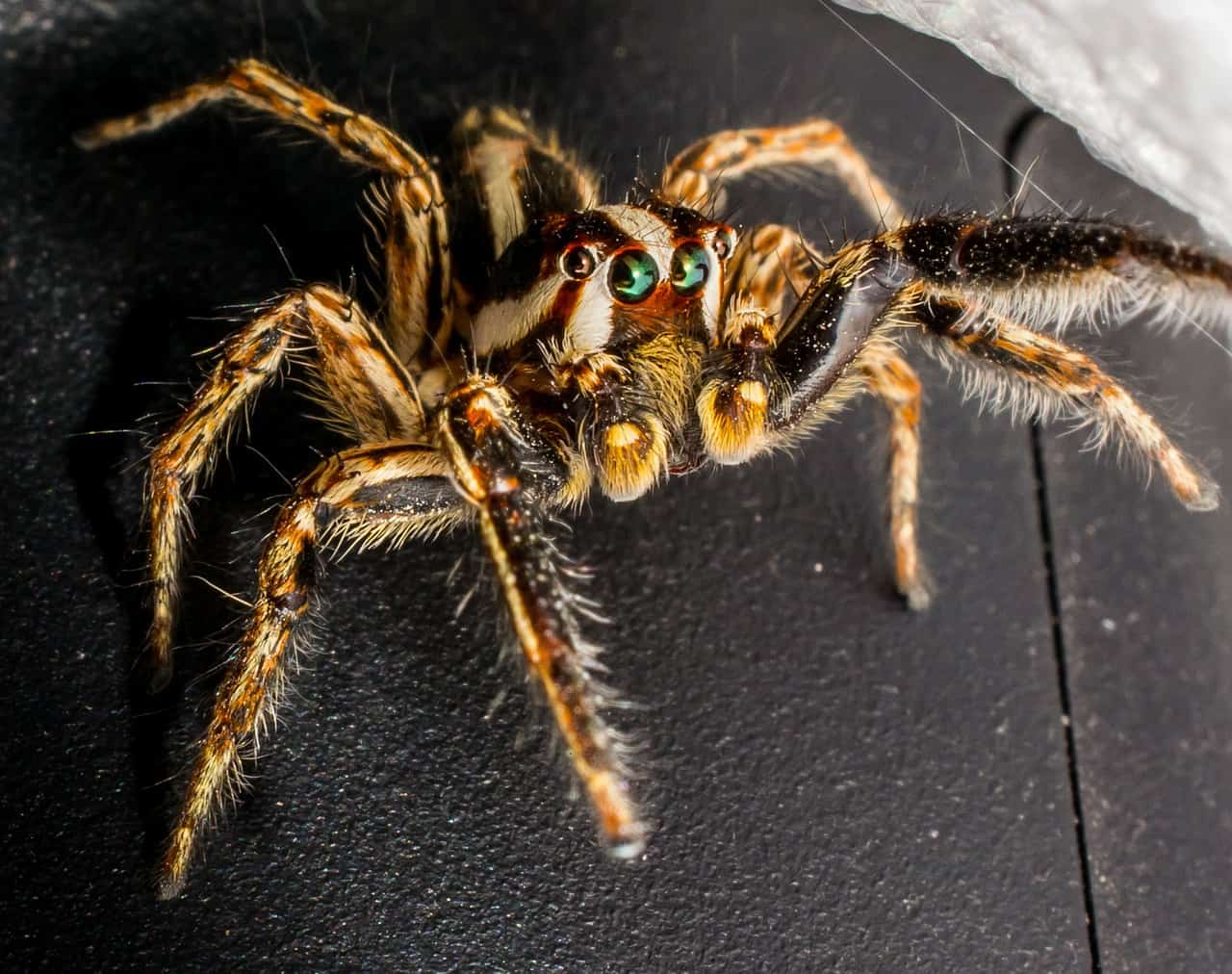
Most people would agree that spiders are kind of creepy, and annoyingly horrible. Yes, spiders generally get a bad reputation. But would you believe that there are spider species that are not only harmless to humans, but are also described as adorable? That’s right. Our jumping spider facts may just change the way you look at spiders, altogether. Jumping spiders have eight eyes, but when viewed up close, their two largest have a cartoonish, watery, pleading appearance. Like a pair of puppy dog eyes!
Plus, they’re easy to take care of. If you want to have one or two as a pet, choose a container that is at least a cubic foot in size to ensure they have enough room to jump. Make sure the lid is with small holes to allow proper airflow for your spider.
They’re the world’s largest group of spiders and they’re all over the face of the Earth. A jumping spider has the ability to do crazy jumps- thus, its name. But apart from that unique characteristic, they also have amazing hearing and vision. From their unusual tricks, traits, and way of life, discover more about them check out our collection of fascinating jumping spider facts!
- Jumping spiders have at least 6,200 species.
- An adult jumping spider could range from 4 to 18 millimeters in size.
- A jumping spider has an average lifespan of at least one year.
- The female jumping spider could lay 30 eggs in just one cocoon.
- Jumping spider species were discovered 54 to 42 million years ago.
- The jumping spider is from the Salticidae family.
- Contrary to common belief, a jumping spider could not kill you.
- The oldest jumping spider fossils were from the Dominican amber.
- A jumping spider looks like they are waving at you.
- They move slowly, but when they sense a threat, they jump very high.
- Jumping spider species do not have muscular legs, but they are agile jumpers.
- Unlike other spiders, they are fearless and like to interact with humans.
- A jumping spider likes to hunt during the day in tropical forests.
- Their breathing system is very well-developed.
- A jumping spider’s venom could actually kill a prey larger than them.
- Just like humans, a jumping spider also has colored vision.
- Scientists say that a jumping spider has a good memory and great eyesight.
- A jumping spider can dance! Yes, they have awesome dance moves.
- Aside from having 8 legs, they also have 4 sets of eyes.
- A jumping spider could jump at least 50 times their body length.
The jumping spider family is everywhere!
Jumping spiders come from the Salticidae family. It is an understatement to say that they’re a pretty big family, as they indeed are. There are 6,200 species of jumping spiders based on recognized fossils and extant. Because of this, they can be found almost everywhere! Although it’s rare to find them in polar regions, they’re in every area in the world.
They prefer to live in tropical areas, but they’re in chiller climates, too. A report also shows that a researcher in 1975 found these spiders on Mount Everest slopes. One of the most common and known types are the ‘Phidippus Regius and Audax species which are usually seen in the eastern part of North America.
A jumping spider's legs are not that super.
We already know that they can jump 50 times higher than their body length. Despite this fact, they do not have muscular legs to support this movement. They mostly rely on blood flow and their segmented legs to do their jumping tricks. When they’re ready to do that jump, their body creates extreme pressure by contracting the muscles of their body’s upper region. This forces the blood from their legs to extend fast. The sudden and quick extension of the legs propels the spider to the direction they’re aiming for.

The silk a jumping spider produces gives them a smooth landing.
Of course, they won’t be doing crazy jumps without having a safety net. Just like other spiders, they also produce silky web. When they jump, it creates a quick web line that serves as their dragline. Through the silk’s help, they eventually have a smooth landing. The web is also a way for them to gain direction, in case they need to pause and stop amid their jump.
A male jumping spider has a special dance.
Did you know that animals also have their own way of flirting? As for a jumping spider, the males would do a unique dance. When the male wants to attract females, they beat their abdomens to the ground. While they’re at it, they also wave their legs up in the air. What’s cool is that jumping spiders would even tap their feet to the ground. This happens so fast even the human eye can’t catch it.
Unlike other spider species, a jumping spider does not use its web to catch prey.
For most spider species, their webs help them catch their meal. But jumping spiders are different. They do not need it, because they can get the same result with their jumping skill. Once they find their target, they merely extend their legs, and add a bit of venom. Most of what they eat are small insects, including plant matter. A jumping spider’s venom is dangerous for some plants, small animals, insects, and other larger animal varieties. But humans do not need to worry as their venom is not enough to harm people.
Instead of having ears, a jumping spider has sensory hairs to hear.
Yes, you read that right. They do not have eardrums or ears to hear. But they do have a great sense of hearing. Thanks to their sensitive, sensory hair, they’re able to take vibration from sound waves. The hair is along a jumping spider’s body, and this serves as a signal to the brain. Researchers only found out about this in 2016. They were studying the eyes of jumping spiders, and accidentally noticed that they could hear the actions of the spider as far as 11 feet away.
The vision of a jumping spider is one of the best in the world.
If you take a closer look, these spiders have weird eye arrangements. In the center of their heads, two smaller eyes fame out two large eyes.
They also have 4 oversized eyes that allow them to have amazing eyesight. The smaller eyes provide them a sense of motion and wide-angle. On the other hand, the larger ones provide them the ability to see color and spatial acuity. Plus, their retinas can even swivel on their own. Thus, they can look around without moving their head.

A jumping spider relies on visual courtship for reproduction.
The courtship displays of jumping spiders are pretty complex. In courtship, male spiders will use their body modifications to perform sideling, zigzag, and vibrational movements. The male will tiptoe towards the female spider. Afterward, the male will then inject his sperm into the opening of the female’s genital area which is near the abdomen.
Although a jumping spider has a tiny brain, they are smart.
Studies show that jumping spiders have a poppy seed-sized brain. This is really small, but this does not determine their intellectual capacity. Research shows that their species plan out intricate and complicated routes for their prey to follow. They even have detours that could land them their next meal!

The most intelligent spider in the world is a jumping spider.
Fringed spiders or the “Portia Fimbriata” are known to be the most intelligent spider in the world. They are usually seen in Southeast Asia and Australia. These spiders usually are 5.2- 10.5 millimeters long. Fringed spiders modify their hunting techniques from time to time, and learn from every hunting situation that they’re in. Through these encounters, they’re able to strategize on how to act next.
Was this page helpful?
Our commitment to delivering trustworthy and engaging content is at the heart of what we do. Each fact on our site is contributed by real users like you, bringing a wealth of diverse insights and information. To ensure the highest standards of accuracy and reliability, our dedicated editors meticulously review each submission. This process guarantees that the facts we share are not only fascinating but also credible. Trust in our commitment to quality and authenticity as you explore and learn with us.
